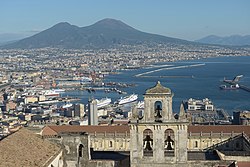South Italy | |
|---|---|
 | |
| Country | Italy |
| Regions | |
| Area | |
• Total | 73,223 km2 (28,272 sq mi) |
| Population (2025) [1] | |
• Total | 13,367,631 |
| • Density | 180/km2 (470/sq mi) |
| Languages | |
| – Official language | Italian |
| – Official linguistic minorities [2] | |
| – Regional languages | |
South Italy (Italian : Italia meridionale or Sud Italia) is one of the five official statistical regions of Italy used by the National Institute of Statistics (ISTAT), a first level NUTS region and a European Parliament constituency. South Italy encompasses six of the country's 20 regions:
Contents
South Italy is defined only for statistical and electoral purposes. It should not be confused with the Mezzogiorno, or Southern Italy, which refers to the areas of the former Kingdom of the Two Sicilies (once including the southern half of the Italian peninsula and Sicily) with the usual addition of the Western Mediterranean island of Sardinia. The latter and Sicily form a distinct statistical region, called Insular Italy.




